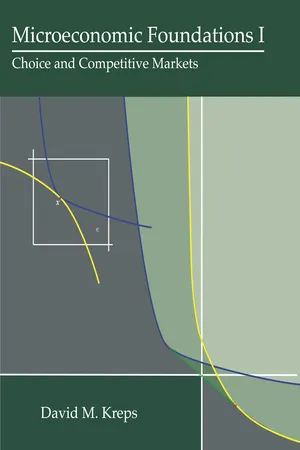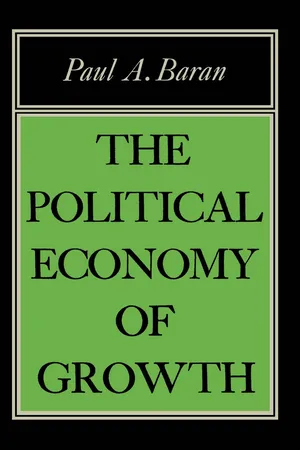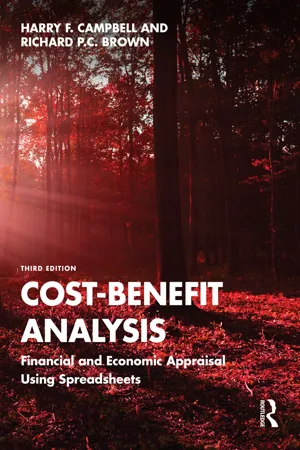Economics
Producer Surplus
Producer surplus is the difference between the price a producer is willing to accept for a good or service and the actual price received. It represents the benefit to producers from selling at a higher price than they were willing to accept. Producer surplus is depicted graphically as the area above the supply curve and below the market price.
Written by Perlego with AI-assistance
Related key terms
7 Key excerpts on "Producer Surplus"
- eBook - ePub
Microeconomic Foundations I
Choice and Competitive Markets
- David M. Kreps(Author)
- 2012(Publication Date)
- Princeton University Press(Publisher)
Chapter TwelveProducer and Consumer Surplus
Most courses in microeconomics at some point engage in policy evaluation: What happens if the government taxes or subsidizes the sale of some good? What happens if a price ceiling or a price floor is established? What if imports into a particular domestic market are capped at some level?The discussion of “what happens?” can begin and end with an analysis of changes in prices and quantities. But when it comes to evaluation, one typically seeks dollar-denominated measures of the impact such policies have on firms inside the industry and on consumers of the specific product. The concepts of producer and consumer surplus appear at this point; the former is advanced as a dollar-denominated measure of the impact the policy has on producers; the latter is asserted to be a dollar-denominated measure of its impact on consumers. These concepts are defined graphically, by pictures such as Figures 12.1a and b . In this chapter, we explore the foundations of these two concepts.Figure 12.1. Producer and consumer surplus. Intermediate-level textbooks in microeconomics often have the pictures shown here, accompanied by text such as “The shaded region in panel a is Producer Surplus, a dollar-denominated measure of the value producers obtain from this market. The shaded region in panel b is consumer surplus, a dollar-denominated measure of the value obtained by consumers.” The objective of this chapter is to make these notions as precise as we can.12.1. Producer Surplus
Producer Surplus has a relatively simple story, although one with a hidden trap. The story concerns the market for a particular good supplied by a number F of firms. We assume that the firms are all competitive, engaged in profit maximization in the sense and style of Chapter 9 ; Zf will denote the production-possibility set of firm f. We let p ∈ be the vector of all prices, and we will suppose that coordinate indices have been chosen so that i - eBook - ePub
Economics For Dummies
Book + Chapter Quizzes Online
- Sean Masaki Flynn(Author)
- 2023(Publication Date)
- For Dummies(Publisher)
less than the $5 per gallon market price. You can see this by the fact that the supply curve lies below the horizontal price line up to the very last drop of the 1,000th gallon. The fact that they receive $5 per gallon for all of it despite being willing to produce it for less is the source of the Producer Surplus, which is represented by the area of the shaded triangle.Using the formula for the area of a triangle ( ), you can compute that the Producer Surplus in this example is $2,000. Producers are $2,000 better off after selling the 1,000 gallons of oil because the total cash they get from selling the 1,000 gallons is $2,000 greater than the minimum amount that they’d have been willing to accept to produce those units.Computing total surplus
The total surplus that society receives from producing the socially optimal level of output of a certain good or service is simply the sum of the consumer surplus and Producer Surplus generated by that output level.Figure 7-6 illustrates total surplus for a market in which the equilibrium price and quantity are, respectively, and . (If this graph looks familiar, that’s because it’s just like Figure 7-1 .)© John Wiley & Sons, Inc.FIGURE 7-6: Total surplus is the sum of consumer surplus and Producer Surplus.I’ve drawn the total surplus area so you can clearly see that it’s made up of consumer surplus (the vertically striped area) plus Producer Surplus (the diagonally striped area). The two are separated by the horizontal line extending from the market equilibrium price ($5).By again using the formula for the area of a triangle, you multiply to figure out that for this graph the total surplus is $16. The total gain to society of producing at this output level is $16.Contemplating total surplus
Total surplus is important because it puts a number on the gains that come from production and trade. Firms make things to generate a profit. People spend money on products because consuming those products makes them happy. And total surplus tells you just how much better off both consumers and producers are after interacting with each other. - eBook - ePub
- Paul A. Baran(Author)
- 2019(Publication Date)
- Monthly Review Press(Publisher)
TWOThe Concept of the Economic SurplusTHE concept of economic surplus is undoubtedly somewhat tricky, and in clarifying and employing it for the understanding of the process of economic development neither simple definitions nor refined measurements can be substituted for analytical effort and rational judgment. Yet it would certainly seem desirable to break with the time-honored tradition of academic economics of sacrificing the relevance of subject matter to the elegance of analytical method; it is better to deal imperfectly with what is important than to attain virtuoso skill in the treatment of what does not matter.In order to facilitate the discussion as much as possible, I shall be speaking now in terms of “comparative statics”: that is, I shall ignore the paths of transition from one economic situation to another, and shall consider these situations, as it were, ex post. Proceeding in this way, we can distinguish three variants of the concept of economic surplus.Actual economic surplus, i.e. the difference between society’s actual current output and its actual current consumption.1 It is thus identical with current saving or accumulation, and finds its embodiment in assets of various kinds added to society’s wealth during the period in question: productive facilities and equipment, inventories, foreign balances, and gold hoards. It would seem to be merely a matter of definition whether durable consumer goods (residential dwellings, automobiles, etc.) should be treated as representing saving rather than consumption, and it is undoubtedly quite arbitrary to treat houses as investment while treating, say, grand pianos as consumption. If the length of useful life be the criterion, where should one place the benchmark? In actual fact, it is essential for the comprehension of the economic process to make the distinction not on the basis of the physical properties of the assets involved, but in the light of their economic function, i.e. depending on whether they enter consumption as “final goods” or serve as means of production contributing thus to an increase of output in the subsequent period. Hence an automobile purchased for pleasure is an object of consumption, while an identical car added to a taxi-fleet is an investment good.2 - eBook - ePub
Cost-Benefit Analysis
Financial and Economic Appraisal Using Spreadsheets
- Harry F. Campbell, Richard P.C. Brown(Authors)
- 2022(Publication Date)
- Routledge(Publisher)
with-and-without comparison conducted in the Efficiency Analysis. In both cases a positive value indicates a more productive use of inputs.We now turn to consumer and Producer Surplus changes associated with the quantity of the output or input traded in the world without the project. As noted above, a fall in output price will benefit the consumers of the original quantity of the good traded, but it will also be to the detriment of the firms supplying the good. Similarly, a rise in input price, such as an increase in the wage, will benefit the suppliers of the original quantity of the input, but will similarly be to the detriment of the firms employing the input and may result in consumers paying higher prices for output These effects are pecuniary effects, as discussed in Section 7.2, and they net out of the Efficiency Analysis. If they are included in the Referent Group Analysis, it is likely to be in the category described by Area C in Table 6.1 (net Referent Group benefits not measured by market prices), given the localised nature of the project’s effects as discussed above. Whether they are relevant to the decision about the project is a matter for the decision-maker, who may not be interested in changes in the distribution of surplus among consumers, labour and firms, especially given that most households represent more than one of these categories of economic agents, but if they are included, and these agents are all members of the Referent Group, they are entered twice in the Referent Group Analysis, once as a benefit and once as a cost, so that they cancel out in the measure of overall project effects, thereby preserving the adding-up property of the cost-benefit model.Suppose now that the output of a project, such as an improvement to a public road leading to a national park, is not marketed. As we saw from Figure 7.1 , the project benefit takes the form of an increase in consumer surplus accruing to users of the park. As in the case of changes in consumer and Producer Surplus induced by changes in market prices and associated with project output or inputs, this form of net benefit is not measured by the Market Analysis. In the case of improved access to the national park, the change in surplus is included in area C or D in Table 6.1 , depending on whether or not the consumers are members of the Referent Group. In contrast to the case of a marketed output, surplus accruing to consumers of the without quantity of the service (Area P0 ABP1 in Figure 7.1 - eBook - ePub
- Neva Goodwin, Jonathan M. Harris, Julie A. Nelson, Pratistha Joshi Rajkarnikar, Brian Roach, Mariano Torras(Authors)
- 2022(Publication Date)
- Routledge(Publisher)
The difference between these two curves at any point represents the gap between the maximum WTP of consumers and the production costs of suppliers. Some of this difference is “captured” by producers as profits, and the rest is consumer surplus. As long as the demand curve is above the supply curve, society receives net benefits by producing that unit of a product. However, if the supply curve is above the demand curve, then marginal costs exceed marginal benefits, and society would actually be worse off if that unit were produced and sold. Thus, as long as the demand curve is higher than the supply curve, it makes sense (from the perspective of social welfare) for society to produce each unit, to the point where marginal benefits equal marginal costs. Note in Figure 5.9 that this is true up to the equilibrium quantity of 700 cups of coffee. However, when the supply curve is higher than the demand curve, marginal costs exceed marginal benefits and society should not produce these units. Any production above 700 cups of coffee would decrease social welfare. In other words, the market equilibrium is the outcome that maximizes social welfare. We now test this result by considering what happens when the market is not allowed to reach equilibrium—when a regulation is enacted that sets a price different from the equilibrium price. 4.2 Price Ceilings Sometimes, governments intervene in markets to set price limits, either above or below the market equilibrium price. Somewhat confusingly, a price set below the market price is called a price ceiling (it is a “ceiling” because it establishes a maximum allowable price). price ceiling: a regulation that specifies a maximum price for a particular product Price ceilings are usually set with the goal of helping certain groups of consumers by keeping prices low. A classic example is rent control, which specifies maximum prices for rental units - eBook - ePub
- Neva Goodwin, Jonathan M. Harris, Julie A. Nelson, Pratistha Joshi Rajkarnikar, Brian Roach, Mariano Torras(Authors)
- 2018(Publication Date)
- Routledge(Publisher)
If the labor market in this hypothetical example were allowed to reach equilibrium, the market-clearing wage rate would be $6.00 per hour and employment would be 2 million workers. But the minimum wage of $7.25/hour prevents market forces from pushing the wage rate any lower than $7.25/hour. The minimum wage is called a price floor because it prevents the wage rate from moving lower, toward equilibrium. Note that if the minimum wage were set below the equilibrium wage, say at $5.00/hour, it would have no effect on the market price.■ Figure 5.11 Welfare Analysis of a Price FloorAt $7.25/hour, the graph tells us that the supply of labor is 2.4 million workers and the demand for labor is 1.7 million workers. Although an equilibrium quantity is determined by the interaction of supply and demand, in the case of a price floor, the market quantity is determined only by the demand curve. In other words, the situation of surplus (excess supply) cannot be eliminated with a price decline, so demand limits the amount that is sold. Thus the presence of the minimum wage, relative to the equilibrium outcome, reduces employment from 2 million to 1.7 million. (Again, these are only hypothetical numbers.)What does this price floor mean in terms of social welfare? Presumably, a minimum wage law is intended to benefit workers, rather than employers. In a labor market, Producer Surplus represents the social welfare benefits to workers—they are the suppliers. Remember that Producer Surplus is the area above the supply curve and below the price, up to the quantity sold. We see in Figure 5.11 that if the market were allowed to reach equilibrium (a wage rate of $6.00/hour), consumer surplus would be areas (A + B + C) and Producer Surplus would be areas (D + E). Total social welfare would be the sum of both surpluses, or (A + B + C + D + E).But with the minimum wage set at $7.25 Producer Surplus becomes areas (B + D). Without the minimum wage, Producer Surplus was (D + E). The way the graph is drawn, it appears that Producer Surplus has increased (i.e., area B, which has been gained, is larger than area E, which has been lost). However, this is not necessarily always the case. To test this, try to draw a market graph in which a price floor decreases Producer Surplus. (Hint: Make the price floor even further above the equilibrium price.) - eBook - ePub
- David Harvey(Author)
- 2018(Publication Date)
- Verso(Publisher)
CHAPTER 3Production and Consumption,Demand and Supply and theRealization of Surplus ValueThe notion that there must be some sort of balance or equilibrium between production and consumption, between demand and supply appears innocuous enough. The primary role of the market in a general system of commodity exchange appears to be to equilibrate demand and supply and thereby achieve the necessary relation between production and consumption. Yet the whole relation between demand and supply, between production and consumption, has been the focus of an immense and occasionally awesome battle in the history of political economy. The intensity of the debate is understandable, since the stakes are high. Not only do we here confront, head-on, the interpretation of business cycles and the short- or long-run stability of capitalism, but we enter into the heart of the controversy over the ultimate viability of the capitalist mode of production itself.In Marx’s time the central point of controversy was over the proposition that supply necessarily created its own demand. There was a variety of nuanced versions of Say’s Law, as it is usually called.1 The simplest states that the incomes paid to the suppliers of factors of production (land, labour and capital) in the form of wages, profits and rents must equal the total price of the goods produced with these factors. This means that ‘the income generated during the production of a given output is equal to the value of that output’, and that any increase in the ‘supply of output means an increase in the income necessary to create a demand for that output’ with the general consequence that ‘supply creates its own demand’. A corollary of the law is that there can be no general overproduction or ‘general glut’ and that crises are the result either of ‘exogenous shocks’ (wars, revolutions, widespread harvest failures, etc.) or of temporary disproportionalities in production. There could be overproduction within an industry or geographical region, but this meant underproduction somewhere else. Transfers of capital and labour could equilibrate the system. What Say’s Law precluded was a general
Index pages curate the most relevant extracts from our library of academic textbooks. They’ve been created using an in-house natural language model (NLM), each adding context and meaning to key research topics.






